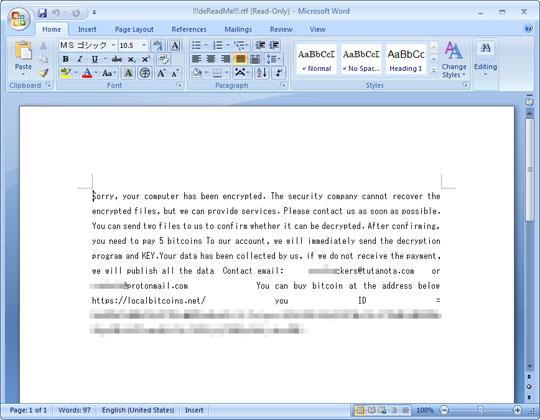Ransom.Win32.CRING.C
N/A;
Windows


Threat Type: Ransomware
Destructiveness: No
Encrypted: Yes
In the wild: Yes
OVERVIEW
Downloaded from the Internet, Dropped by other malware
This Ransomware arrives on a system as a file dropped by other malware or as a file downloaded unknowingly by users when visiting malicious sites.
It executes then deletes itself afterward.
It requires being executed with a specific argument/parameter, an additional component, or in a specific environment in order to proceed with its intended routine.
It drops files as ransom note.
TECHNICAL DETAILS
3,281,988 bytes
EXE
24 Feb 2021
Connects to URLs/IPs, Displays message/message boxes, Encrypts files, Disables AV services, , Deletes files
Arrival Details
This Ransomware arrives on a system as a file dropped by other malware or as a file downloaded unknowingly by users when visiting malicious sites.
Installation
This Ransomware adds the following processes:
- {Malware Filepath}\Go.bat "{Malware Filepath}\{Malware Filename}.exe"
- wmic shadowcopy delete
- bcdedit /set {default} bootstatuspolicy ignoreallfailures
- bcdedit /set {default} recoveryenabled no
- {Malware Filepath}\killme.bat "{Malware Filepath}\{Malware Filename}.exe"
It executes then deletes itself afterward.
Other System Modifications
This Ransomware deletes the following files:
- {Malware Filepath}\Go.bat
- {Malware Filepath}\killme.bat
- {Drive Letter} are the following:
- D:\
- E:\
- F:\
- G:\
- H:\
- {Filename} are files that satisfies the following filters:
- *.VHD
- *.bac
- *.bak
- *.wbcat
- *.bkf
- *.set
- *.win
- *.dsk
- Backup*.*
- backup*.*
- {Drive Letter} are the following:
Process Termination
This Ransomware terminates the following services if found on the affected system:
- Services that start with:
- mssql
- sql
- postgresql
- oracle
- mysql
- veeam
- backup
- msexchange
Dropping Routine
This Ransomware drops the following files:
- {Malware Filepath}\Go.bat
- {Malware Filepath}\killme.bat
Other Details
This Ransomware encrypts files with the following extensions:
- .xlsx
- .png
- .fob
- .jp?
- .lic
- .dcm
- .cf?
- .rvt
- .cpp
- .qb?
- .cs
- .sln
- .vb
- .xml
- .dwg
- .edb
- .ndf
- .wk
- .xl?
- .txt
- .doc?
- .md?
- mp?
- .sql
- .bak
- .ora
- .pp?
- .dbf
- .zip
- .rar
- .asp?
- .php
- .jsp?
- .bk?
- .csv
- .7z
- .myd
- .ibd
- _fsm
- _vm
- .db?
- .rpt
It does the following:
- Argument must be equal to "rsa" to proceed in encrypting files
- It writes the following to the command prompt:
- "What the FUck" → before the encryption routine
- "EZ Games" → after the encryption routine
It requires being executed with a specific argument/parameter, an additional component, or in a specific environment in order to proceed with its intended routine.
Ransomware Routine
This Ransomware avoids encrypting files found in the following folders:
- %Windows%
(Note: %Windows% is the Windows folder, where it usually is C:\Windows on all Windows operating system versions.)
It appends the following extension to the file name of the encrypted files:
- {BLOCKED}ackers@tutanota.com.cring
It drops the following file(s) as ransom note:
- %System Root%\!!!deReadMe!!!.rtf
- %Public%\Desktop\!!!deReadMe!!!.rtf

SOLUTION
9.800
16.560.02
25 Feb 2021
16.561.00
26 Feb 2021
Step 1
Trend Micro Predictive Machine Learning detects and blocks malware at the first sign of its existence, before it executes on your system. When enabled, your Trend Micro product detects this malware under the following machine learning name:
- Troj.Win32.TRX.XXPE50FFF041
Step 2
Before doing any scans, Windows 7, Windows 8, Windows 8.1, and Windows 10 users must disable System Restore to allow full scanning of their computers.
Step 3
Note that not all files, folders, and registry keys and entries are installed on your computer during this malware's/spyware's/grayware's execution. This may be due to incomplete installation or other operating system conditions. If you do not find the same files/folders/registry information, please proceed to the next step.
Step 4
Search and delete this file
- %System Root%\!!!deReadMe!!!.rtf
- %Public%\Desktop\!!!deReadMe!!!.rtf
- {Malware Filepath}\Go.bat
- {Malware Filepath}\killme.bat
Step 5
Scan your computer with your Trend Micro product to delete files detected as Ransom.Win32.CRING.C. If the detected files have already been cleaned, deleted, or quarantined by your Trend Micro product, no further step is required. You may opt to simply delete the quarantined files. Please check the following Trend Micro Support pages for more information:
Step 6
Restore encrypted files from backup.
Did this description help? Tell us how we did.

